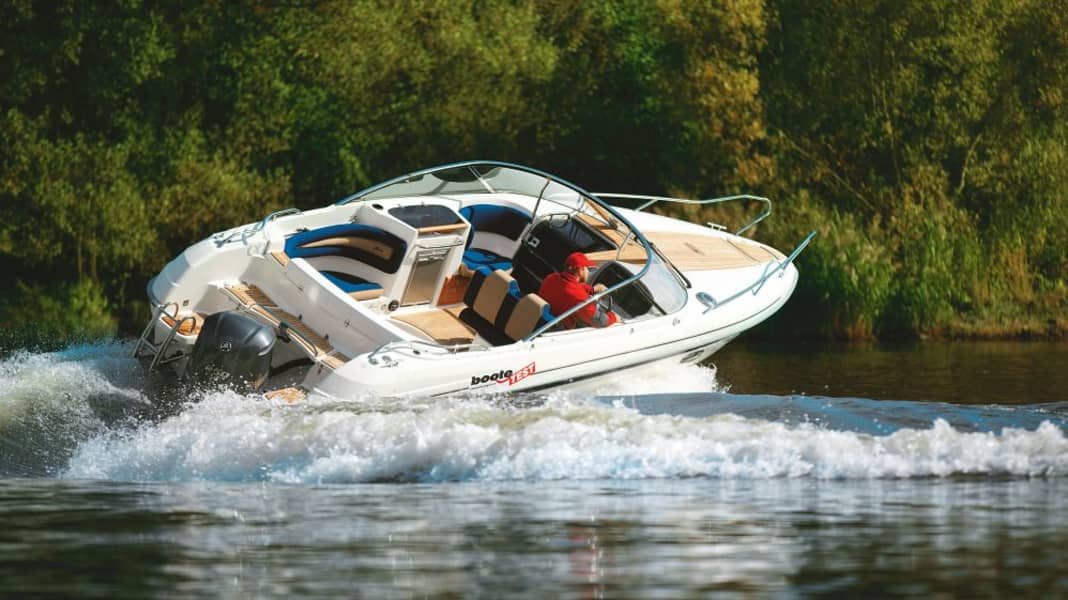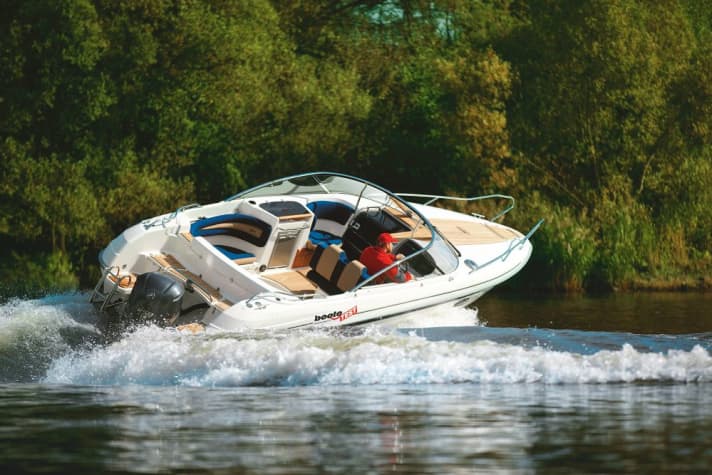







When buying a new boat, the first thing you usually look at is the length and price and check that the personal budget is not exceeded. However, in many cases, a standard boat is only sparsely equipped; one or two items from the surcharge list have to be ordered in order to be able to use the boat properly and the total price climbs.
Not so with the Yamarin 76 DC. Here, the standard equipment with bow thruster, convertible top, windscreen wipers, seat and sun lounger cushions, teak floor, Wallas cooker and trim tabs is very extensive and the basic price is correspondingly higher. If this equipment is still not enough, you can order additional accessories from the optional list, which contains only a few items.
Driving and manoeuvring
The shipyard has certified the 76 DC in accordance with CE category C, i.e. for coastal waters. Yamarin recommends outboards between 150 and 300 hp for propulsion. A 250 hp V6 four-stroke engine from Yamaha is installed on our test boat. The driver's steering command is transmitted directly to the engine via the hydraulic SeaStar steering system. The basic setting for the maximum steering angle on the boat we drove needs to be adjusted because the engine cover hits the side of the bathing platform.
The Yamarin manoeuvres well even in small harbours. This is due to turning circles of 1 ½ boat lengths forward over starboard and port as well as the short reaction time of 1 to 3 s when reversing with the gear engaged backwards. The Yamarin is stable on course up to 6 knots with low wave formation. It is irrelevant whether someone on board is changing places or walking around. The sailing angle (longitudinal trim) also changes only slightly when the boat changes from displacement to planing. During the entire process, the foresight remains unobstructed.
If the driver forgets this and accelerates in cruising trim, the bow rises higher and the transition takes longer - but even then the foresight is not obscured by the bow. We measured the lowest glide speed at 2800 rpm without the support of the standard trim tabs. In the full load range, the engine turns at a maximum of 5800 rpm according to the rev counter and takes the test boat to a top speed of 46 knots. At the same time, 1.87 l/sm runs through the fuel line. Acoustically, the F250D makes itself heard at a low 85 dB/A.
The Yamarin 76 DC runs economically in combination with the Yamaha when the engine's multifunction display shows 3500 rpm. At the same time, the GPS shows a speed of 24 knots. In this case, one tank of fuel is sufficient for a distance of 136 nm until the reserve is used up. Longer distances can only be travelled in displacement at canal speed. - The pleasure is relatively short at full throttle: refuelling is then necessary after just 86 nm (plus 15 % reserve). This corresponds to a journey time of less than two hours.
When manoeuvring at fast planing speeds, the Yamarin 76 DC provides a "positive driving experience". In increasingly tighter circles, the boat leans slightly towards the centre of the turn, whereby the hull brakes without rocking or hooking even at the slightest planing speed. If you set the steering wheel back to "straight ahead", the boat accelerates without ventilating.
If you forget to activate the trim switch and trim the engine to the transom before entering the bend, the propeller quickly starts to ventilate and the boat rocks slightly and safely over the longitudinal axis. Thanks to the direct steering, which is also smooth in this situation, the 180° turns are as unspectacular as normal bends. This also applies to the rudder twisting at top speed; the Yamarin glides absolutely safely over the imaginary slalom course.
The River Main was as smooth as glass on the test day, so inland waterway waves had to be used to assess the rough water characteristics. The hull travelled through these cleanly and gently. The bow distributes spray water sideways without it being carried into the boat.
The driver and front passenger sit together on a comfortable bench with slightly offset seats. The front part of the seat can be folded up to provide more space when the boat is stationary - or simply to sit higher. For an additional passenger, the Finnish boat builders have incorporated a seat in the cockpit side wall between the galley and the companionway. All other guests are seated in the rear part of the cockpit on the U-shaped bench seat. The driver's work area is ergonomically well designed and gives no cause for criticism.
Engine, tank, electrics
Outputs of 250 hp are no problem for modern outboards. The arrangement of the cylinders one above the other ensures ease of servicing and compact dimensions. Inboards in the same power class require more space and have a weight problem compared to outboards, which becomes apparent when it comes to trailer weight.
The 190-litre plastic fuel tank and a standard pre-filter with water separator are housed under the cockpit floor at the rear. We did not see a separate fuel tap, but we did see two sturdily mounted batteries and an electrical panel with automatic fuses and main battery switch in the left cockpit stowage box. Accessibility is good, as you would expect from Scandinavian boats. An empty conduit between the engine and the through-hull passage ensures tidiness and protection from UV rays for the cables to the outboard motor.
Security
The way to the foredeck is via the centre aisle in the windscreen. Three steps facilitate the ascent, while teak panelling and railing ensure stability and safe movement. Yamarin has equipped the 76 DC with a three-step, 0.90 m long folding ladder to make it easy to get onto the small bathing platform after a swim. There is a transition in front of the motor that connects both sides next to the motorised tub. When the engine is raised for road transport or changing the propeller, it pushes the gangway upwards via a roller system. In this way, Yamarin utilises space that would otherwise not be available. The test boat's equipment with fire extinguisher and electric and manual bilge pump is praised in view of the fact that this is standard.
Living and cockpit
Below deck, the Yamarin offers four berths. Two forward in the bow and the others under the cockpit floor in a slip cabin. The latter is accessible from the forward cabin, albeit only on all fours. To the right and left of this double berth there is plenty of storage space along the entire length. The bow berth is made up of the V-shaped bench seat and a wooden board with cushions. Storage compartments under the bench seat, shelves and a small cupboard are ideal for storing on-board utensils.
A special feature for a boat in this category is the pump toilet, which is located under a cover in the cabin and is partitioned off with a curtain. A 30-litre faeces tank serves as temporary storage. Cooking and washing up is done in the cockpit on a Wallas cooker, as is the standard refrigerator (48 litres with freezer compartment), pressurised water system with 45-litre tank and the pre-installation for a Wallas 1800 heater.
Equipment
A convertible top, which is stored in a compartment around the stern bench seat, protects against rain and sun. The anchor locker in the bow has no bow fitting, but is self-draining. An electric anchor winch can be ordered at the bow and stern for an extra charge. The boat is moored to four
well dimensioned cleats. Fenders are attached to the side of the railing. A plastic rubbing strake protects against bumps.
Data sheet: Yamarin 76 DC
Shipyard: Yamarin
Type designation: Yamarin 76 DC
CE category: C - Coastal waters
Material of hull and deck: Plastic
Length: 7,52 m
Width: 2,60 m
Displacement: 1,65 t
Price: 90.685,00 €

